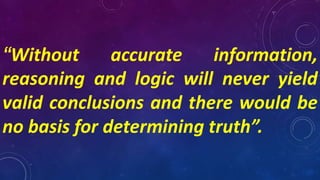
information accuracy.pptx
- 1. “Without accurate information, reasoning and logic will never yield valid conclusions and there would be no basis for determining truth”.
- 2. WHATISINFORMATION? facts provided or learned about something or someone.
- 3. ACCURACY General: Freedom from error (correctness), or closeness to truth or fact, resulting from exercise of painstaking care or due diligence. Accuracy depends on how the data is collected, and is usually judged by comparing several measurements from the same or different sources. Read more: http://www.businessdictionary.com/definition/accuracy.html
- 5. It relates to “the correctness of the output information” (Bailey & Pearson, 1983). It is one of the elements of intrinsic data quality (Wang & Strong, 1996)
- 6. QUALITIES Accurate Information should be fair and free from bias. It should not have any arithmetical and grammatical errors. Information comes directly or in written form likely to be more reliable than it comes from indirectly (from hands to hands) or verbally which can be later retracted.
- 7. Complete Accuracy of information is just not enough. It should also be complete which means facts and figures should not be missing or concealed. Telling the truth but not wholly is of no use
- 8. Cost-beneficial Information should be analyzed for its benefits against the cost of obtaining it. It business context, it is not worthwhile to spend money on information that even cannot recover its costs leading to loss each time that information is obtained. In other contexts, such as hospitals it would be useful to get information even it has no financial benefits due to the nature of the business and expectations of society from it.
- 9. User-targeted Information should be communicated in the style, format, detail and complexity which address the needs of users of the information. Example senior managers need brief reports which enable them to understand the position and performance of the business at a glance, while operational managers need detailed information which enable them to make day to day decisions
- 10. Relevant Information should be communicated to the right person. It means person which has some control over decisions expected to come out from obtaining the information. Authoritative Information should come from reliable source. It depends on qualifications and experience and past performance of the person communicating the information.
- 11. Timely Information should be communicated in time so that receiver of the information has enough time to decide appropriate actions based on the information received. Information which communicates details of the past events earlier in time is of less importance than recently issued information like newspapers. What is timely information depends on situation to situation. Selection of appropriate channel of communication is key skill to achieve.
- 12. EasytoUse Information should be understandable to the users. Style, sentence structure and jargons should be used keeping the receiver in mind. If report is targeted to new-comer in the field, then it should explain technical jargons used in the report.
- 13. INFORMATIONSOURCES Primary Sources of Information: Primary sources are original materials. They are from the time period involved and have not been filtered through interpretation or evaluation. Primary sources are original materials on which other research is based. They are usually the first formal appearance of results in physical, print or electronic format. They present original thinking, report a discovery, or share new information. The definition of a primary source may vary depending upon the discipline or context
- 14. •Artifacts (e.g. coins, plant specimens, fossils, furniture, tools, clothing, all from the time under study); •Audio recordings (e.g. radio programs) •Diaries; •Internet communications on email, list serves; •Interviews (e.g., oral histories, telephone, e-mail); •Journal articles published in peer-reviewed publications; •Letters; •Newspaper articles written at the time;
- 15. Secondary Sources of Information: Secondary sources are less easily defined than primary sources. Generally, they are accounts written after the fact with the benefit of hindsight. They are interpretations and evaluations of primary sources. Secondary sources are not evidence, but rather commentary on and discussion of evidence. However, what some define as a secondary source, others define as a tertiary source. Context is everything. The definition of a secondary source may vary depending upon the discipline or context.
- 16. •Bibliographies (also considered tertiary); •Biographical works; •Commentaries, criticisms; •Dictionaries, Encyclopedias (also considered tertiary); •Histories; •Journal articles (depending on the disciple can be primary);
- 17. TertiarySourcesofinformation: Tertiary sources consist of information which is a distillation and collection of primary and secondary sources.
- 18. •Bibliography of Bibliographies; •Almanacs; •Bibliographies (also considered secondary); •Chronologies; •Dictionaries and Encyclopedias(also considered secondary); •Directories; •Fact books; •Guide books;
- 19. PLAGIARISM According to the Merriam-Webster online dictionary, to "plagiarize" means: • to steal and pass off (the ideas or words of another) as one's own • to use (another's production) without crediting the source • to commit literary theft • to present as new and original an idea or product derived from an existing source
- 20. All of the following are considered plagiarism: • turning in someone else's work as your own • copying words or ideas from someone else without giving credit • failing to put a quotation in quotation marks • giving incorrect information about the source of a quotation • changing words but copying the sentence structure of a source without giving credit • copying so many words or ideas from a source that it makes up the majority of your work, whether you give credit or not (see our section on "fair use" rules)